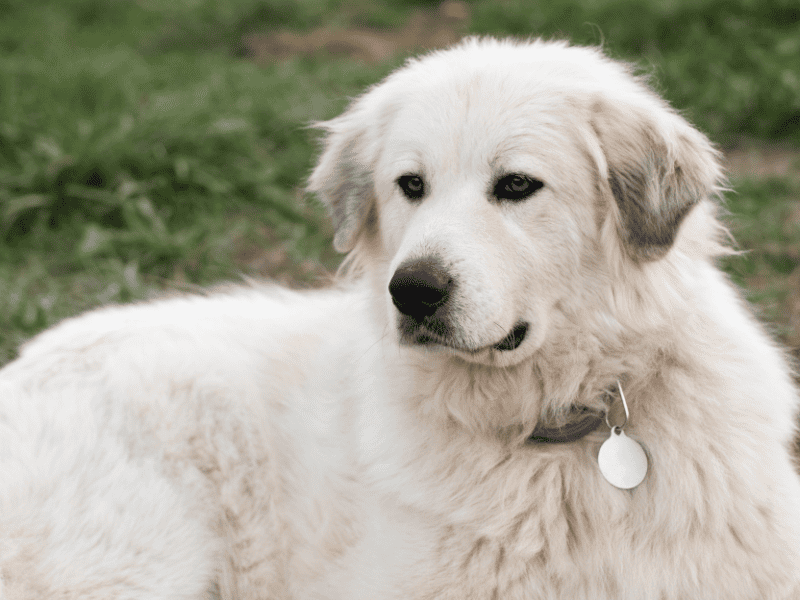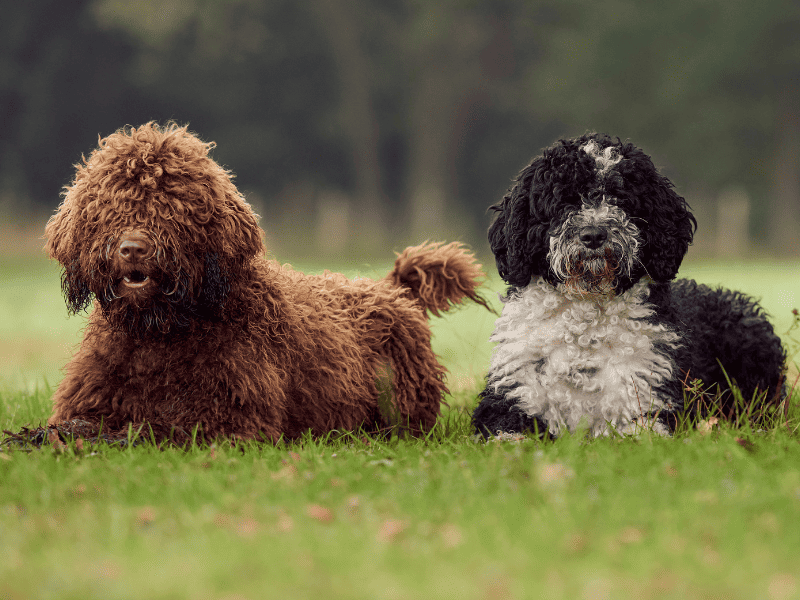The Pyrenees Dog, or the Great Pyrenees, is a huge breed! They can stand up to 32 inches tall and weigh from 85 to 160 pounds. The size comes with a strong and muscular build, which makes them great for herding, guarding and protecting livestock. People usually take notice of these dogs, so owners must understand their specific needs.

Pyrenees Dogs are known for their gentle and loving temperament. They are also loyal and protective of their families. In addition, they are very smart and can be taught. However, it’s important for owners to show themselves as the pack leader and provide proper training and socialization.
These dogs have an independent and sometimes stubborn personality. Despite being capable and adaptable, they may decide to do their own thing. This can make training difficult, but owners can handle it with patience, consistency and firm leadership. This way, they can create a strong bond with their Pyrenees Dog.
To sum it up, Pyrenees Dogs are impressive dogs that need special attention due to their size. They are affectionate and smart. Yet, owners must show themselves as leaders and provide consistent training and socialization. By understanding the unique characteristics of the Pyrenees Dog, owners will have a rewarding and satisfying companionship experience.
The Average Size of Great Pyrenees Dogs
The average size of Great Pyrenees dogs is a topic of great interest. From understanding how genetics and parental breeds influence their size to the significance of meeting the parents when selecting a puppy, this section provides valuable insights into the factors that determine the size of these majestic dogs.
How Size is Influenced by Genetics and Parental Breeds
Genetics and parental breeds are key when it comes to size of Great Pyrenees dogs. Traits from mom and dad, like height, weight, and body shape, can give clues about how big the pup will grow up. Great Pyrenees are selectively bred for certain characteristics, and size is one of them. So, when picking a puppy, it’s important to consider the size of both parents.
The genetic makeup from mixed breeds, like Maremma Sheepdog and Saint Bernard, also play a role in size. Prospective owners should keep this in mind when selecting a puppy.
Nutrition is also a factor. Puppyhood nutrition is vital for healthy development and steady growth. Proper nutrition helps them reach their full size potential.
It’s all about understanding genetics and parental breeds when considering a Great Pyrenees dog. Meet the parents or end up with surprise genes, it’s like a DNA blind date for your future furball. Consider genetics, parent breed info, and nutrition to make an informed decision and pick a puppy that will be a healthy and appropriately-sized adult dog.
Importance of Meeting the Parents when Choosing a Puppy
Choosing a puppy? Meet the parents! Seeing them reveals potential size and characteristics of the Great Pyrenees. Genetics and parental breeds make a difference. Get an idea of their size and temperament to make an informed decision about the puppy’s growth.
Also, assess any health issues that may be present in the lineage. Large breed dogs like Great Pyrenees are prone to certain conditions. Interact with the parents to sense their overall health and if they show signs of these conditions.
Additionally, observe the parents’ behavior and temperament. Great Pyrenees dogs are loyal and protective, but each may have a different personality. Spending time with both parents gauges the temperament and if it fits your needs.
In conclusion, meeting the parents when choosing a Great Pyrenees puppy is key for understanding size, health risks, and temperament. It’s better than relying on external factors. Taking the time to meet both parents gives valuable insights into the new furry family member.
Growth Stages and Rate of Great Pyrenees Puppies
Great Pyrenees puppies go through various growth stages at a remarkable rate. In this section, we will explore growth charts and weight predictors that can help you track the growth of your Great Pyrenees.

We’ll also touch upon crucial factors such as genetics and nutrition that play a significant role in their growth. Additionally, we’ll provide you with valuable tips to ensure the healthy development of your beloved furry friend.
Growth Charts and Weight Predictors for Great Pyrenees
Growth and weight of Great Pyrenees dogs can be monitored with the help of growth charts and weight predictors. These tools give info on expected growth patterns and development. By checking their progress, owners can make sure their Great Pyrenees puppies are growing properly.
A table with columns representing different age intervals or months can show this growth chart data. It will have info like the average weight range for each age group, so owners can compare with their puppy’s weight. This representation helps spot any deviations from the norm.
It is important to note that these averages do not always apply due to factors like genetics and nutrition. Therefore, consulting a veterinarian is essential for an accurate assessment of the puppy’s growth. Regular vet check-ups are crucial for monitoring the growth of Great Pyrenees dogs and making sure they reach important milestones.
In conclusion, growth charts and weight predictors are useful for tracking growth of Great Pyrenees dogs. They help owners ensure their puppies are growing healthily. However, individual variations exist due to genetics and nutrition. Consulting a vet regularly provides accurate assessment of a Great Pyrenees dog‘s growth and well-being. If you want your Great Pyrenees to reach their full size potential, feed them genetics and nutrition… or just compliments and bacon bits.
Factors Affecting Growth, Such as Genetics and Nutrition
Genetics and nutrition play a huge role in the growth of Great Pyrenees dogs. Traits from their parental breeds can influence their growth potential. Nutrition is essential to support their healthy growth. Feeding them a balanced diet, with proper nutrients, can significantly affect their growth rate.
Moreover, other factors can also affect the growth of Great Pyrenees dogs. These include: parental breeds, exercise, environment, and care. Genetics and nutrition lay the foundation.
But, providing a stimulating and nurturing environment, along with regular exercise, can further support their physical development. Regular veterinary check-ups are essential to monitor their growth and ensure they are on track for healthy development.
Tips for Supporting Healthy Growth and Development
Ensure the healthy growth and development of your Great Pyrenees puppy with these key tips:
- Provide a nutritionally balanced diet
- Encourage regular exercise
- Focus on socialization and training
These steps will help create a strong foundation for them to thrive physically, mentally, and emotionally. Monitor their growth closely too, with regular vet check-ups. This way, any potential issues can be identified and dealt with quickly. By being proactive and prioritizing their wellbeing, owners can guarantee a long and happy life with their beloved pup.
Understanding the Adult Size and Weight of Great Pyrenees
Curious about the adult size and weight of Great Pyrenees? Unraveling the mysteries behind their growth, this section explores general guidelines for their size, exceptional cases of smaller-than-expected dogs, and the importance of regular veterinary check-ups to monitor their growth.

From standard expectations to unexpected variations, we’ll delve into the facts and figures to give you a comprehensive understanding of the adult size and weight of these majestic canines.
General Guidelines for Adult Size of Female and Male Great Pyrenees
Female and male Great Pyrenees dogs vary in size when adults. It’s good to know the adult size to decide if one of these dogs fits into your home. Here’s a table with general guidelines:
| Female Great Pyrenees | Male Great Pyrenees | |
|---|---|---|
| Height | 25-29 inches | 27-32 inches |
| Weight | 85-115 pounds | 100-160 pounds |
These figures are only an average. Genetics and other factors may cause variation. Some Great Pyrenees can be smaller than expected due to genetic variations or health issues. Regular vet checks help monitor growth. Surprising exceptions reveal the secrets of petite Great Pyrenees!
Exceptional Cases: Why Some Dogs May Be Smaller Than Expected
Genetics and parental breeds can influence the size of Great Pyrenees dogs. Yet, some dogs may be smaller than usual. When picking a pup, it’s best to meet the parents. This helps to guess the pup’s size as an adult.
Growth charts and weight predictors can help estimate size. Nutrition and vet check-ups are key for healthy growth.
Though there are guidelines for female and male adult size, there can be exceptions. Health problems or genetic variations can keep a dog from growing fully. Regular vet check-ups help make sure your dog is healthy.
To understand why some dogs are smaller than expected, consider the breed’s characteristics and history. Great Pyrenees have a long history as livestock guardians in mountainous regions. This may explain size variations.
Most Great Pyrenees stick to average size. But there are cases where certain factors cause them to be smaller. By considering genetics, nutrition, regular vet care, and understanding the breed, pet owners can support their pup’s healthy growth and development.
Importance of Regular Veterinary Check-ups for Monitoring Growth
Regular vet check-ups are a must for Great Pyrenees growth monitoring. They are key for ensuring health and development, as well as recognizing any potential issues. Owners can keep an eye on growth patterns, as well as track weight gain, by visiting a vet regularly.
Vet check-ups give professionals the chance to check how the pup is progressing and suggest exercise and nutrition advice. They can review if the dog is hitting milestones according to its breed, and give recommendations based on the pup’s individual needs.
Keep in mind that genetics and nutrition play a major role in Great Pyrenees growth. Check-ups enable proper assessment of these factors, so the pup can get the best care. For example, one pup’s growth rate had slowed down compared to others. But, thanks to regular visits, the vet discovered a nutritional deficiency causing the slowdown. With quick adjustments, the pup soon caught up with its peers in size and weight.
To sum up, regular vet check-ups are essential for Great Pyrenees growth and development. Through these visits, experts can track weight gain, consider genetic influences, address nutrition, and give advice to ensure optimal care. By attending to these routine examinations, owners can make sure their Great Pyrenees grows into a healthy adult dog.
Characteristics and Temperament of Great Pyrenees
Discover the captivating characteristics and endearing temperament of Great Pyrenees! From their rich history and unique breed traits to their exercise needs and health concerns, we’ll explore what makes this large breed truly special.
Uncover the secrets behind their noble nature and gain insights into the financial considerations of providing superior veterinary care for these magnificent dogs. Get ready to dive into a world of fascinating facts about the Great Pyrenees breed!
Overview of Great Pyrenees Breed Traits and History
Great Pyrenees dogs have unique traits and an interesting past. They’re known for their size, strength, and protective nature. These pooches come from the Pyrenees Mountains in France and Spain, bred to guard livestock and protect their people. With a thick double coat, they can handle rough weather.
These pups are gentle and loving with their families, but can be wary of strangers. They make excellent watchdogs due to their instinct to protect. They have a calm and patient temperament, so they’re great for families with kids. Socialization from an early age is important to help them be good around other animals and people.
Exercise needs for Great Pyrenees dogs are moderate. They can live in both rural and urban environments. Grooming is a must for their coats, as they shed heavily twice a year. Health concerns commonly associated with the breed include hip dysplasia, heart disease, and bloat. Regular vet visits are key for keeping them healthy and addressing any issues.
All in all, Great Pyrenees dogs have an amazing past and unique traits. Their size, protective nature, and gentle temperament make them amazing family pets! So, brush away the fluff and sweat away the pounds – exercise and grooming go paw in paw for these furry friends!
Exercise and Grooming Needs for Great Pyrenees
Exercise and grooming are crucial for Great Pyrenees! Regular exercise keeps them fit and healthy. Their thick, double coat needs brushing to prevent mats and tangles. Nail trimming is a must, and eye and ear care should be regularly checked. Dental hygiene is important too – brushing their teeth and giving them dental treats or toys.

These big dogs need lots of exercise and socialization with people and other animals. They have strong herding instincts and need lots of space to release energy in a healthy way. Historically, they were used for guarding livestock. Now, they’re still known for their guarding abilities and are often used as working dogs or family pets.
Be a responsible owner and know the health concerns and importance of veterinary care for your Great Pyrenees.
Health Concerns and Importance of Veterinary Care
The Great Pyrenees has certain health issues that need frequent vet care. Keep an eye out and be proactive in monitoring their well-being. Regular check-ups help detect issues early, so prompt treatment can be done. Plus, vaccines and preventive care are needed.
Hip dysplasia is a problem for this breed because of size and genetics. Visits to the vet can diagnose and manage this. Medication and physical therapy can help. Bloat is also a life-threatening condition. Vet intervention is needed to treat and prevent it.
Eye diseases, such as PRA and cataracts, may occur. These can cause vision impairment or blindness if left untreated. Regular eye exams by a vet will help identify them early and allow treatment options.
Be a responsible owner and prioritize the Great Pyrenees’ overall well-being. This includes visits to the vet, preventive care, and addressing health concerns. Being proactive in your dog’s healthcare will give them a happy and healthy life.
Financial Considerations: Pet Insurance for Great Pyrenees
Investing in pet insurance for your Great Pyrenees can prove to be beneficial. It can provide financial protection, comprehensive coverage, and peace of mind. Different plans are available, so make sure to understand the terms and conditions for the one you select. This way, you can provide the best possible medical care without worrying about the cost.
Before getting a Great Pyrenees, it’s important to know about their size, growth, and care.
Final Thoughts on the Breed Pyrenees
In the concluding section, we’ll summarize the important details about the size, growth, and care of the Great Pyrenees breed. Additionally, we’ll provide final thoughts and considerations for those who are looking to own and care for a Great Pyrenees dog.
Summary of Great Pyrenees Size, Growth, and Care
Great Pyrenees dogs are a large breed known for their size, growth, and care needs. It’s important to understand these factors if you’re thinking of owning one.
The average size of a Great Pyrenees can vary due to genetics and their parents’ breeds. That’s why it’s best to meet the parents when you choose a puppy.
Growth stages and rate of Great Pyrenees puppies are key. Growth charts and weight predictors can help estimate how your dog will grow. Genetics and nutrition both affect their growth, so it’s important to take care of them in those areas.
You should also know the adult size and weight of your Great Pyrenees. Generally, females tend to be smaller than males, but this can be different in some cases. Regular check-ups with the vet will help keep an eye on growth and overall health.
It’s also important to recognize their breed traits and exercise and grooming needs. Don’t forget to take care of any health issues and get professional veterinary care.
Financially, pet insurance can help cover any unexpected medical bills.
To summarise, understanding size, growth, and care needs of Great Pyrenees is essential if you want to own this breed. Being aware of genetics, managing nutrition, monitoring adult sizes, and acknowledging their breed traits will ensure optimal health and well-being throughout their lives.
Final Thoughts on Owning and Caring for a Great Pyrenees Dog
Owning a Great Pyrenees dog involves understanding its size, growth rate, and temperament. When choosing a puppy, meet the parents for insights into potential size and character. Regular vet check-ups are essential for monitoring growth and health. Exercise, grooming, nutrition, and access to veterinary care are key for a healthy life. Additionally, pet insurance can help with unexpected medical expenses.
Sometimes, the pup might be smaller than expected due to genetics or other factors. Vet check-ups can detect any abnormalities or health issues during development. To ensure optimal care for a Great Pyrenees, follow the guidelines for exercise, grooming, and nutrition. Neglecting these responsibilities can lead to health problems or decrease the quality of life.
Approaching the responsibility of owning a Great Pyrenees with dedication and attentiveness is key. Provide them with the necessary care and attention to ensure a long and happy life. Prioritize regular vet check-ups, exercise, grooming, nutrition, and pet insurance to ensure their overall well-being.
Some Facts About Pyrenees Dog Size: What to Know About this Large Breed:
- The average size of a male Great Pyrenees is 110-120 lbs and 28-32 inches tall, while females average 80-95 lbs and 26-29 inches tall.
- It takes about two years for a Great Pyrenees to reach their full size, and they are considered to be a giant and extra-large breed.
- Great Pyrenees can grow from weighing 5 pounds at birth to around 105 pounds in one year.
- The Great Pyrenees Growth Chart and Weight Calculator can help predict the adult size and weight of a Great Pyrenees puppy.
- Great Pyrenees are large, calm, and well-mannered dogs that make excellent family pets. They have a height range of 25-32 inches and can weigh over 100 pounds.


Leave a Reply